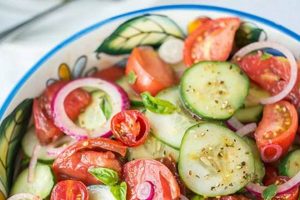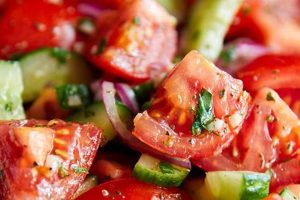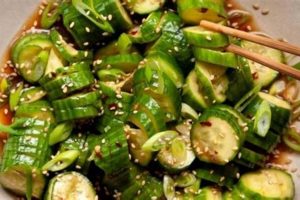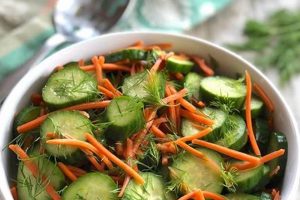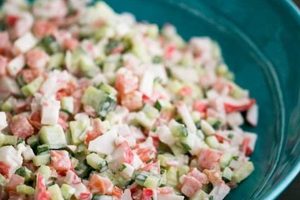A guide for preparing a dish of sliced cucumbers dressed with a creamy sauce based on sour cream typically involves ingredients like vinegar, dill, onion, and sometimes garlic or sugar for a sweet and tangy flavor profile. Variations can include additions like fresh herbs, spices, or other vegetables. This cool and refreshing salad is often served as a side dish, complementing heavier meals, particularly during warmer months.
The simplicity and adaptability of this dish contribute to its popularity. It offers a light yet flavorful counterpoint to rich or spicy foods. The sour cream provides a creamy texture and tangy base, while the cucumbers offer a refreshing crunch. The combination of these elements creates a balance of flavors and textures, making it a versatile accompaniment to various cuisines. Historically, cucumbers and sour cream or similar dairy products have been culinary staples in various cultures, suggesting this dish likely has roots in traditional European cuisine. Its ease of preparation and refreshing nature have solidified its place as a beloved side dish.
This exploration will delve further into variations of the dish, offering specific ingredient lists, step-by-step instructions, and tips for achieving optimal flavor and presentation. Nutritional information and suggested pairings will also be provided.
Tips for a Perfect Cucumber Salad
Achieving optimal flavor and texture in a cucumber salad requires attention to detail. These tips offer guidance for creating a consistently delicious and visually appealing dish.
Tip 1: Salt the Cucumbers: Salting the sliced cucumbers draws out excess moisture, preventing a watery salad. Place the cucumber slices in a colander, sprinkle with salt, and let them sit for 15-20 minutes before rinsing and patting dry.
Tip 2: Thinly Slice the Cucumbers: Evenly thin slices ensure the cucumbers absorb the dressing properly and offer a pleasant texture. A mandoline slicer or sharp knife can be used for consistent results.
Tip 3: Use High-Quality Sour Cream: The flavor of the sour cream is central to the dish. Opting for a full-fat, high-quality sour cream contributes significantly to the overall taste and richness.
Tip 4: Fresh Dill is Key: Fresh dill provides a bright, herbaceous flavor that complements cucumbers and sour cream. Dried dill can be used as a substitute if fresh is unavailable, but use it sparingly.
Tip 5: Balance Sweetness and Acidity: A touch of sugar or honey balances the tartness of the vinegar and sour cream. Adjust these elements to personal preference.
Tip 6: Chill Before Serving: Chilling the salad allows the flavors to meld and enhances the refreshing qualities of the dish. Refrigerate for at least 30 minutes before serving.
Tip 7: Consider Textural Variety: Adding thinly sliced red onion or a sprinkle of chopped chives provides textural contrast and visual appeal.
By following these guidelines, one can elevate a simple cucumber salad to a truly delightful culinary experience. The result is a refreshing, flavorful, and visually appealing dish suitable for any occasion.
The following section provides concluding thoughts on preparing and enjoying this versatile side dish.
1. Fresh Cucumbers
Fresh cucumbers are fundamental to a successful sour cream cucumber salad. Their crisp texture and mild, refreshing flavor provide the foundation upon which the other ingredients build. Using less-than-fresh cucumbers, those that are soft, bruised, or have begun to develop seeds, compromises the overall quality of the salad. Such cucumbers contribute excess moisture, diluting the dressing and resulting in a less appealing, watery consistency. The flavor profile also shifts, losing its delicate freshness and potentially introducing undesirable bitterness.
Selecting firm, unblemished cucumbers with vibrant green skin is crucial. Smaller cucumbers often possess fewer seeds and a higher water content, leading to a more refreshing final product. Storing cucumbers properly, ideally refrigerated and wrapped in a slightly damp paper towel, preserves their freshness and extends their shelf life. Examples of the negative impact of using subpar cucumbers include a diluted, watery dressing, a less crisp texture, and an overall diminished flavor experience. These outcomes underscore the direct correlation between cucumber quality and the final dish’s success.
Prioritizing the use of fresh, high-quality cucumbers ensures the desired crispness, refreshing flavor, and overall balance of the salad. This focus on a key ingredient elevates a simple side dish into a truly satisfying culinary experience. Proper selection and storage techniques play an integral role in achieving this outcome, contributing to a consistently delicious and visually appealing salad.
2. High-Quality Sour Cream
High-quality sour cream plays a pivotal role in the overall success of a sour cream cucumber salad. The sour cream provides the foundational creamy texture and tangy flavor that define the dish. Its quality directly impacts the final product’s taste, texture, and overall appeal. Using a high-quality sour cream, characterized by a rich, smooth consistency and a clean, tangy flavor, creates a luxurious mouthfeel and a balanced flavor profile. Conversely, lower-quality sour creams, often thinner and possessing a less pronounced flavor, can result in a watery dressing and a less satisfying culinary experience. This distinction highlights the cause-and-effect relationship between sour cream quality and the final dish.
Consider a scenario where a low-fat or generic brand sour cream is used. The resulting dressing may be thin and lack the desired creamy texture. The flavor might also be bland, failing to provide the characteristic tang that complements the cucumbers. In contrast, a high-quality, full-fat sour cream creates a dressing that clings beautifully to the cucumbers, delivering a rich, satisfying mouthfeel and a vibrant, tangy flavor that enhances the overall experience. This comparison underscores the practical significance of selecting the right sour cream.
The selection of high-quality sour cream represents a crucial step in crafting a truly exceptional sour cream cucumber salad. Its impact on the final product’s flavor, texture, and overall appeal is undeniable. Choosing a sour cream with a rich, smooth consistency and a clean, tangy flavor ensures a dressing that elevates the simple combination of cucumbers and seasonings into a delightful culinary creation. This understanding allows for consistent preparation of a high-quality dish that satisfies the palate and provides a genuinely enjoyable dining experience.
3. Fresh Dill
Fresh dill is integral to a well-executed sour cream cucumber salad, contributing a distinctive aromatic and flavor profile that elevates the dish beyond a simple combination of ingredients. Its bright, herbaceous notes complement the cool cucumbers and tangy sour cream, creating a balanced and refreshing flavor experience. Understanding the role of fresh dill in this culinary context involves exploring its various facets.
- Aromatic Enhancement
Dill’s volatile oils impart a distinct aroma that significantly enhances the sensory experience of consuming the salad. These aromatic compounds, released upon crushing or chopping the dill, create a vibrant and refreshing olfactory element. The aroma interacts with the flavors of the other ingredients, creating a complex and layered sensory perception. Imagine the difference between smelling freshly cut dill compared to dried dillthe fresh herb offers a much more potent and nuanced aroma, crucial for elevating the salad’s overall appeal.
- Flavor Complexity
Beyond its aromatic contribution, fresh dill adds a complex layer of flavor to the salad. Its slightly tangy, almost anise-like flavor complements the cucumbers’ subtle sweetness and the sour cream’s tanginess. This interplay of flavors creates a balanced profile that is both refreshing and satisfying. Consider a salad made without dillthe flavor would be noticeably simpler, lacking the depth and complexity that fresh dill provides.
- Visual Appeal
The vibrant green of fresh dill adds a visually appealing element to the salad. Its feathery fronds create a textural contrast against the smooth sour cream and sliced cucumbers. This visual enhancement increases the dish’s overall aesthetic appeal, making it more enticing. A salad garnished with fresh dill appears brighter and more inviting compared to one without.
- Freshness Indicator
The use of fresh dill signals an emphasis on quality and freshness in the preparation of the salad. Its inclusion suggests a commitment to using high-quality ingredients, which contributes to the overall perception of the dish. This attention to detail distinguishes a thoughtfully prepared salad from a more perfunctory one. The presence of fresh dill acts as a visual cue, indicating a focus on freshness and flavor.
These facets of fresh dill highlight its indispensable role in a sour cream cucumber salad recipe. Its contributions extend beyond mere flavoring, enhancing the aroma, visual appeal, and overall sensory experience. The interplay of these elements demonstrates the importance of ingredient selection in creating a truly satisfying culinary composition. By understanding and appreciating the contributions of fresh dill, one can elevate a simple cucumber salad to a more sophisticated and enjoyable dish.
4. Balanced Seasoning
Balanced seasoning is paramount in a successful sour cream cucumber salad recipe. It transforms simple ingredients into a harmonious and flavorful dish. The delicate flavor profile of cucumbers and the creamy tang of sour cream provide a neutral canvas, necessitating careful seasoning to achieve optimal taste. Understanding the nuances of balanced seasoning is essential for creating a truly satisfying culinary experience.
- Salt: Enhancing Flavor and Texture
Salt not only enhances the inherent flavors of the cucumbers and sour cream but also plays a crucial role in managing moisture content. Salting the cucumbers prior to dressing draws out excess water, preventing a watery salad and promoting a crisper texture. Furthermore, salt amplifies the perception of sweetness and acidity, contributing to a more complex flavor profile. The difference between a properly salted salad and an under-salted one is significant; the former boasts vibrant flavors and a pleasant texture, while the latter tastes bland and watery.
- Acidity: Balancing Richness and Providing Brightness
Acidity, typically from vinegar, is essential for balancing the richness of the sour cream and adding brightness to the salad. The tartness of the vinegar cuts through the creamy base, preventing the salad from feeling heavy or overly rich. Common choices include white vinegar, apple cider vinegar, or even a splash of lemon juice. Each option offers a slightly different flavor profile, influencing the overall taste of the salad. For example, apple cider vinegar adds a subtle fruity sweetness, while white vinegar provides a sharper, cleaner acidity.
- Sweetness: A Touch of Balance
A touch of sweetness, often from a small amount of sugar or honey, balances the tartness of the vinegar and sour cream. This addition rounds out the flavor profile, creating a more harmonious and nuanced taste experience. The sweetness should be subtle, enhancing the other flavors rather than dominating them. The amount of sweetener used can be adjusted to personal preference, with some recipes omitting it altogether.
- Aromatics: Elevating the Sensory Experience
Aromatics, such as fresh dill, chives, or even a pinch of garlic powder, add another layer of complexity to the salad. These ingredients introduce aromatic notes that enhance the overall sensory experience. Fresh dill, with its bright, herbaceous aroma, is a classic pairing with cucumbers and sour cream. Other options, like chives or garlic, provide different nuances, allowing for customization based on individual preferences. The judicious use of aromatics can elevate the salad from simple to sophisticated.
These elements of balanced seasoning work synergistically to create a sour cream cucumber salad that is more than the sum of its parts. The careful consideration of salt, acidity, sweetness, and aromatics results in a dish that is both refreshing and flavorful, showcasing the importance of balanced seasoning in elevating simple ingredients to a culinary masterpiece. A well-seasoned salad offers a complex interplay of flavors and textures, demonstrating the transformative power of balanced seasoning in a seemingly simple dish.
5. Proper Chilling
Proper chilling is a crucial step in preparing a sour cream cucumber salad, significantly impacting the final dish’s flavor, texture, and overall enjoyment. Chilling allows the flavors of the various componentscucumbers, sour cream, vinegar, herbs, and any additional ingredientsto meld and harmonize. Furthermore, it enhances the refreshing quality of the salad, making it particularly appealing in warmer weather. This exploration delves into the multifaceted benefits of proper chilling.
- Flavor Development
Chilling allows the flavors of the individual ingredients to meld, creating a more complex and nuanced flavor profile. The cucumbers’ subtle sweetness, the sour cream’s tanginess, the herbs’ aromatics, and the vinegar’s sharpness combine harmoniously during the chilling process. A freshly made salad, while palatable, often lacks the depth of flavor achieved through chilling. The chemical interactions between the ingredients intensify over time in a cool environment, leading to a more pronounced and balanced taste.
- Texture Enhancement
Chilling firms the cucumbers, enhancing their crispness. This contrasts pleasingly with the creamy texture of the sour cream dressing. The temperature also affects the perception of texture; a chilled salad offers a more refreshing and satisfying mouthfeel than one served at room temperature. Consider the difference between biting into a chilled cucumber versus one at room temperaturethe chilled cucumber offers a more pronounced crunch.
- Refreshment Factor
A chilled cucumber salad is inherently more refreshing than one served at room temperature. The cool temperature provides a welcome contrast, especially during hot weather or when served alongside heavier, richer dishes. The physiological response to cold temperatures further enhances the sensation of refreshment. This cooling effect contributes significantly to the appeal of the salad as a light and refreshing side dish.
- Food Safety
Chilling also plays a crucial role in food safety, particularly with dairy-based dressings like sour cream. Maintaining a low temperature inhibits the growth of bacteria, ensuring the salad remains safe for consumption. Proper chilling is especially important if the salad will not be consumed immediately after preparation. Adhering to food safety guidelines, including proper chilling, is essential for preventing foodborne illnesses.
These facets of proper chilling demonstrate its significance in preparing a high-quality sour cream cucumber salad. The chilling process is not merely a final step but rather an integral part of the recipe, contributing to flavor development, texture enhancement, heightened refreshment, and food safety. By understanding and applying the principles of proper chilling, one can elevate a simple cucumber salad to a truly delightful and satisfying culinary experience. Neglecting this step compromises the dish’s potential, resulting in a less flavorful, less refreshing, and potentially less safe final product. The attention to detail demonstrated through proper chilling reflects a commitment to culinary excellence and enhances the overall enjoyment of the dish.
6. Thin Slicing
Thin slicing of cucumbers is a critical technique in achieving a successful sour cream cucumber salad. It directly influences flavor absorption, texture, and overall aesthetic appeal. Thinly sliced cucumbers offer a greater surface area for the sour cream dressing to adhere to, ensuring each bite delivers a balanced flavor profile. Thicker slices, conversely, limit flavor penetration, resulting in a less satisfying experience where the cucumber and dressing flavors remain separate. This difference underscores the cause-and-effect relationship between slicing technique and flavor development. Imagine biting into a thinly sliced cucumber coated in a creamy, flavorful dressing compared to a thick slice where the dressing primarily sits on the surface; the former offers a more harmonious blend of flavors.
Beyond flavor, thin slicing contributes significantly to the salad’s textural appeal. Thin slices offer a delicate, almost melt-in-your-mouth texture that contrasts pleasantly with the creamy richness of the sour cream. Thick slices, in contrast, can be perceived as dense and unwieldy, potentially overpowering the other elements of the salad. This textural contrast is essential for a balanced and enjoyable culinary experience. Consider the difference in texture between a thinly shaved cucumber and a thickly chopped one in the context of a delicate salad; the thin shavings integrate seamlessly, while the thick chunks disrupt the overall texture.
Thin slicing also contributes to the visual appeal of the salad. Uniformly thin slices create a visually appealing presentation, enhancing the dish’s overall aesthetic value. This attention to detail elevates the dining experience, demonstrating care and precision in preparation. The visual uniformity suggests a level of culinary expertise and adds to the perceived value of the dish. A salad composed of uniformly thin cucumber slices appears more refined and elegant than one with unevenly chopped pieces, showcasing the practical significance of this technique in achieving both culinary and aesthetic excellence. This understanding emphasizes the importance of thin slicing as a crucial component in a well-executed sour cream cucumber salad.
7. Optional Additions
Optional additions represent a significant opportunity to personalize and enhance the standard sour cream cucumber salad recipe. These additions, while not essential to the core dish, introduce layers of flavor, texture, and visual appeal, transforming a simple salad into a more complex and nuanced culinary creation. Their impact ranges from subtle nuances to significant shifts in the overall flavor profile, offering a range of possibilities for customization. For example, the addition of thinly sliced red onion introduces a pungent bite that contrasts with the creamy dressing, while a sprinkle of fresh chives contributes a mild onion flavor and a pop of color. Understanding the potential of optional additions allows for a tailored approach to preparing this versatile salad.
The strategic use of optional additions can address specific culinary goals. For instance, incorporating chopped walnuts or sunflower seeds adds a satisfying crunch and a boost of healthy fats. A sprinkle of paprika introduces a subtle smokiness, while a dash of hot sauce adds a fiery kick. The choice of additions depends on individual preferences and the desired outcome. Consider a scenario where a richer flavor profile is desired; incorporating crumbled feta cheese adds a salty, tangy element that complements the existing flavors. Alternatively, for a lighter and brighter salad, a squeeze of lemon juice and a handful of chopped fresh mint can be incorporated. These examples illustrate the practical significance of understanding how various additions can modify and enhance the basic recipe.
Careful consideration of optional additions allows for a high degree of control over the final product’s flavor and texture. This customization potential elevates the sour cream cucumber salad from a simple side dish to a more versatile and adaptable culinary creation. While the core components of cucumbers, sour cream, and seasonings establish the foundation, optional additions provide the opportunity for creative expression and personalized flavor experiences. The ability to tailor the recipe to specific tastes and dietary needs underscores the value of understanding and utilizing optional additions effectively. This knowledge empowers individuals to create a dish that not only satisfies but also delights, showcasing the transformative potential of thoughtful ingredient selection.
Frequently Asked Questions
This section addresses common inquiries regarding the preparation and variations of sour cream cucumber salad, providing clear and concise information to ensure optimal results.
Question 1: Can alternative herbs be substituted for fresh dill?
While fresh dill is traditionally preferred for its distinct flavor profile, other fresh herbs such as parsley, chives, or mint can be substituted. Dried dill can also be used, but it should be added sparingly due to its more concentrated flavor. The choice of alternative herbs depends on individual preferences and the desired flavor outcome.
Question 2: How can excess moisture in the salad be prevented?
Salting the sliced cucumbers before adding them to the salad draws out excess moisture. Place the cucumber slices in a colander, sprinkle with salt, and let them sit for 15-20 minutes. Rinse the cucumbers thoroughly and pat them dry before combining them with the other ingredients. This process is crucial for maintaining a desirable texture and preventing a watery salad.
Question 3: What type of vinegar is best suited for this salad?
White vinegar, apple cider vinegar, and white wine vinegar are all suitable options. White vinegar offers a clean, sharp acidity, while apple cider vinegar contributes a subtle sweetness. White wine vinegar provides a milder, more nuanced acidity. The choice depends on personal preference and the desired flavor profile.
Question 4: Can this salad be made ahead of time?
Yes, the salad can be made ahead of time and stored in the refrigerator. However, it’s generally recommended to prepare the salad no more than a few hours in advance to maintain optimal freshness and texture. The flavors will meld and intensify as the salad chills, enhancing the overall taste experience.
Question 5: How can the salad be adapted for different dietary restrictions?
The recipe can be easily adapted to accommodate various dietary needs. For vegan or dairy-free versions, substitutes like cashew cream or coconut yogurt can replace sour cream. Adjustments to the seasonings may be necessary to balance the flavor profile. For those watching sodium intake, reducing the amount of added salt is advisable, and unsalted herbs and spices can be used.
Question 6: How can the nutritional value of the salad be enhanced?
Adding ingredients like chopped nuts, seeds, or other vegetables increases the nutritional content. Chopped walnuts or sunflower seeds contribute healthy fats, while bell peppers or shredded carrots boost vitamin and mineral intake. These additions not only enhance the nutritional profile but also add textural and flavor complexity.
These frequently asked questions provide a deeper understanding of how to create a delicious and personalized sour cream cucumber salad. Attention to detail in each step, from ingredient selection to chilling time, results in a consistently satisfying dish.
The following section provides a concluding summary of key considerations and encourages further exploration of this versatile salad.
Conclusion
Exploration of the elements contributing to a successful cucumber salad featuring a sour cream-based dressing reveals the importance of ingredient quality, preparation techniques, and balanced seasoning. Fresh, crisp cucumbers, high-quality sour cream, and the aromatic presence of fresh dill form the foundation of this classic dish. Proper chilling allows flavors to meld, while thin slicing optimizes texture and flavor absorption. Attention to detail, such as salting the cucumbers to remove excess moisture, ensures a desirable consistency. Optional additions, ranging from pungent red onion to crunchy nuts and seeds, offer opportunities for customization and enhanced nutritional value.
The simplicity of this salad belies its potential for culinary refinement. Understanding the interplay of ingredients and techniques empowers one to create a consistently delicious and refreshing dish. Further exploration of variations, including different herbs, spices, and additional vegetables, promises continued enjoyment and culinary discovery. This foundational knowledge allows adaptation to individual preferences and dietary needs, solidifying the cucumber salad with sour cream dressing as a versatile and enduring culinary staple.

